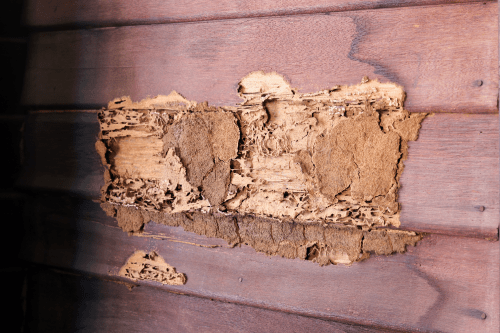Home / Blog / Termites / Subterranean Termites vs. Drywood Termites—Which Is Worse?
Subterranean Termites vs. Drywood Termites—Which Is Worse?

Scientifically reviewed by Daniel Baldwin, BCE, CCFS, CP-FS
-Published on December 16, 2022
-Updated on July 13, 2023
You might think all termites are the same, but several different varieties exist. And while most of us believe termites are damaging insects, they actually play an essential role in the natural world. By breaking down wood, they help to return fallen trees to other parts of the ecosystem. The trouble is, they don’t care whether the wood they’re eating is deadfall in a forest or a vital part of the structure of your home. Read on to discover more about these types of termites.
What are subterranean termites?
Subterranean termites are social insects, meaning that they live in colonies. Other types of social insects are ants and some species of wasps. Subterranean termites live underground in moist soil, extracting the water they need to thrive.
Subterranean termites can be found in all states in the US except for Alaska. They are a tan or cream color, ranging from ⅛ inch to 1 inch in length. Worker termites are wingless and don’t reproduce, while reproductive termites have wings and are often confused with flying ants.
Using their saw-like mandibles, subterranean termites eat 24/7, munching through any type of wood they encounter and leaving behind channels sometimes referred to as “mud tubes.”
Termite damage costs US homeowners an average of $5 billion per year. Given enough time, subterranean termites will all but hollow out a piece of lumber, leaving only a husk of wood and a distraught homeowner in their wake.
What are drywood termites?
Unlike their soil-dwelling cousins, drywood termites make their homes inside the wood they eat. Drywood termites can be up to one inch long and when they do have wings, the wings are much longer than their body.
Because they live inside the wood—like structural timber and furniture—detecting drywood termites can be difficult until repair work is done and a colony is found. Drywood termites have no reason to leave their homes to find food, so you won’t see them in transit. They only come outside when swarming, so seeing a swarm near or inside of your home can indicate an infestation.
What type of termite is the worst?
When it comes to subterranean termites versus drywood termites, it’s a close battle between which type of termite is the worst to have in your home. The short answer is: neither are good, of course. Depending on where you live, either one can invade your home and cause severe damage.
How can you prevent termites?
Termites establish colonies by getting into the structure of your home through any tiny holes that might lead to the studs, beams, rafters, and wood subflooring. Once they have access to the wood structure of your home, they can quickly spread undetected, which makes prevention all the more important.
The best way to avoid a termite infestation is to seal all gaps and cracks that could give these tricky insects access to your home. Another common way termites can enter your home is through any soil that touches the wood structure of your house. Creating a barrier between soil and wood will help keep subterranean termites away.
What can you do if you have a termite infestation?
If you suspect a termite problem, call a local pest control company and have them come to your home for an assessment. Don’t wait—termite damage can progress very quickly. Professionals look for indications of damage and excrement from termites to determine if an infestation is likely.
Hawx Pest Control uses an industry-leading termite control solution called the Sentricon System, which uses a specialized agent that prevents subterranean termites from molting, causing them to die. Bait stations are placed strategically around your home to address existing termites and prevent new ones from entering. Studies have shown that the Sentricon System dramatically reduced termite activity within a month of installation.
Termite infestations are many homeowners’ worst nightmare, for a good reason. If you find yourself in this position, your local Hawx team is ready and waiting. We have knowledgeable technicians, state-of-the-art equipment, and the best available products to assist you with your termite infestation and help prevent further damage.
Related Articles
Visit our blog to learn more.
→








